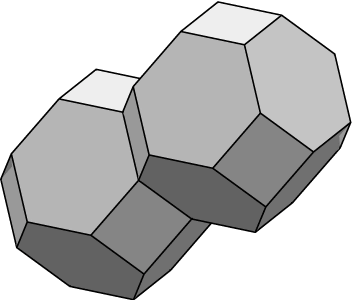
The datafile handles the wrapping of edges around the torus by specifying for each direction whether an edge wraps positively (+), negatively (-), or not at all (*).
Note the use of the keyword TORUS_FILLED in the datafile.
This informs Evolver that one of the volume constraints is redundant,
preventing a singular matrix when the time comes to enforce volume
constraints. One could use just TORUS and only put on one
volume constraint.
The display of a surface in a torus can be done several ways.
The connected
command (my favorite) makes each body show as a single unit.
The clipped
command shows the surface clipped to the fundamental
parallelpiped. The raw_cells
command shows the unedited surface.
The Weaire-Phelan structure
[WP].
is in the datafile phelanc.fe.
It has area 0.3% less than Kelvin's.
 |
The initial two-cell Kelvin shape. Note that due to periodidity, a single vertex or edge may appear multiple times in the image. |
// twointor.fe // Two Kelvin tetrakaidecahedra in a torus. TORUS_FILLED // signals that domain is a torus and bodies fill it. periods 1.000000 0.000000 0.000000 0.000000 1.000000 0.000000 0.000000 0.000000 1.000000 vertices // values from another program 1 0.499733 0.015302 0.792314 2 0.270081 0.015548 0.500199 3 0.026251 0.264043 0.500458 4 0.755123 0.015258 0.499302 5 0.026509 0.499036 0.794636 6 0.500631 0.015486 0.293622 7 0.025918 0.750639 0.499952 8 0.499627 0.251759 0.087858 9 0.256701 0.499113 0.087842 10 0.026281 0.500286 0.292918 11 0.500693 0.765009 0.086526 12 0.770240 0.499837 0.087382 edges // with wraps in axis directions 1 1 2 * * * 2 2 3 * * * 3 1 4 * * * 4 3 5 * * * 5 2 6 * * * 6 2 7 * - * 7 1 8 * * + 8 4 6 * * * 9 5 9 * * + 10 3 10 * * * 11 3 4 - * * 12 6 8 * * * 13 6 11 * - * 14 7 4 - + * 15 8 12 * * * 16 9 8 * * * 17 9 11 * * * 18 10 7 * * * 19 11 1 * + - 20 12 5 + * - 21 5 7 * * * 22 11 12 * * * 23 10 12 - * * 24 9 10 * * * faces 1 1 2 4 9 16 -7 2 -2 5 12 -16 24 -10 3 -4 10 18 -21 4 7 15 20 -4 11 -3 5 -1 3 8 -5 6 6 14 -11 -2 7 5 13 -17 24 18 -6 8 -12 13 19 7 9 -16 17 22 -15 10 -10 11 8 12 15 -23 11 -21 9 17 19 1 6 12 -14 -18 23 -22 -13 -8 13 -24 -9 -20 -23 14 -19 22 20 21 14 -3 bodies 1 -1 -2 -3 -4 -5 9 7 11 -9 10 12 5 14 3 volume 0.500 2 2 -6 -7 8 -10 -12 -11 -13 1 13 -14 6 4 -8 volume 0.500Doing some refining and iterating will show that the optimal shape is curved a bit.